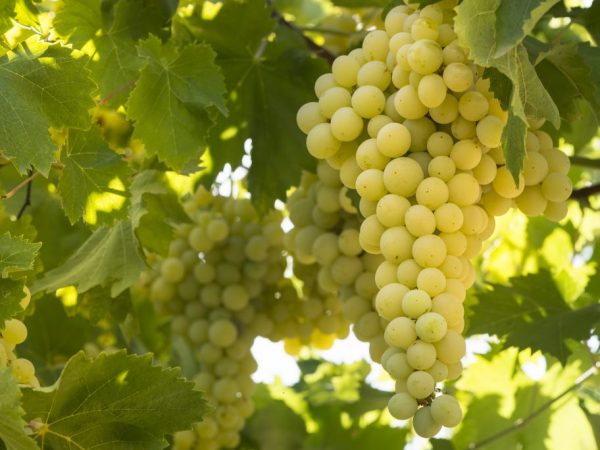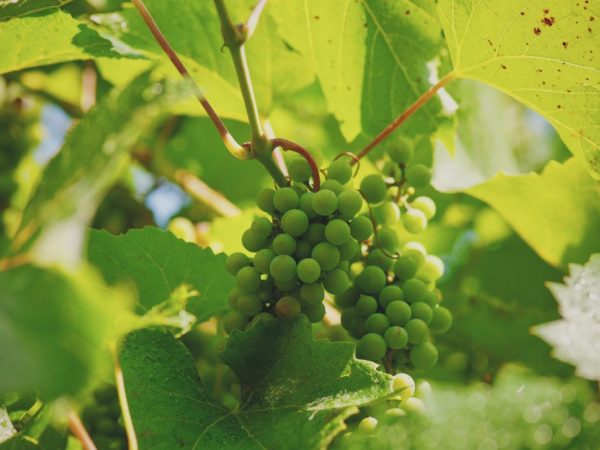Growing grapes Solaris
When growing grapes in the north, it is important to choose a good variety. For these purposes, Solaris grapes, which are characterized by resistance to snow and frost, are ideal. This hybrid variety is a product of German breeding and was obtained after crossing the Ottonel and Saperavi varieties.

Growing grapes Solaris
Variety characteristics
Fruiting is observed early, 2 years after planting. This crop is considered self-pollinated, therefore it is allowed to grow only on the site. The growing season is short, the crop is harvested in early August. The yield is good: from 1 ha to 200 kg.
Description of the tree
According to the description, the Solaris grape bush is tall (up to 4-5 m), has a spreading vine. It is thin but strong. The leaves are large, with 5 lobes. There are small jagged areas at the edges of the plate.
- large light green berries, weight up to 10 g, round shape;
- large clusters, weight up to 1 kg;
The taste is sour for the first few years. Sweetness increases with age and acidity decreases. A feature of Solaris grape varieties is that they are suitable for making delicious wine with a pleasant Muscat aroma and pear aftertaste.
Growing rules
The advantage of this variety is that it is allowed to grow on any soil. The only exceptions are marshy and too wet lands. When choosing a location, keep in mind that this grape variety needs moderate moisture and a lot of sunlight. They prefer the hills located on the south side of the garden. Solaris does not tolerate excess magnesium in the ground. In the presence of this component, Kalimag (200 g / m²) is added to the soil. Under the condition of increased acidity of the soil, liming of the site is carried out (2 kg / m²).
The seedling must be grafted. Its length is 1 m, and the length of the roots is 25 cm. It is better to use a 2-year-old planting material. This increases its resistance to disease.
It is customary to prepare a planting hole in the fall. For this, a hole is dug, 1 m deep and 80 cm wide. A drainage system is installed at the bottom using crushed stone or sawdust. On top of the drainage, 1 bucket of humus is poured, which during the winter will saturate the earth with the necessary microelements. In the spring, before planting, a small embankment is made in the hole, into which the planting material is placed. The roots are evenly distributed over the entire width of the hole and sprinkled with earth. At a distance of 10 cm from the pit, a metal support is added. Since the plant is vigorous, there is a possibility of deformation in adverse weather.
Care activities

The plant needs to be watered regularly
Watering is carried out a year after planting. It is better to pour water into a special hole, the depth of which is no more than 20 cm. It is better to use warm water for irrigation. The soil moisture interval depends on the growing region. In the southern or central regions of the country - 10 days. In other areas - up to 20 days. After each watering, after 3-4 days, remove all weeds and loosen the top layer of the earth.This will allow air and moisture to penetrate the root system better.
Fertilization is an important step in maintenance.
- The first feeding is carried out 2 years after planting - the plant begins to bear fruit.
- In the spring, the bushes are fed with a solution of potassium nitrate (20 g per 5 liters of water).
- At the end of summer, a solution of potassium monophosphate (50 g per 10 l of water) is introduced, which accelerates the formation of berries and saturates the bunches with juiciness.
Solutions are applied at the rate of 20 liters for each bush. In autumn, subject to severe winter frosts, it is better to cover the root part with agrofibre or mulch the earth with humus.
For the fruits to ripen faster, they need a lot of sun and air. Annually, in the spring, the lower part of the bush is pruned. For this, 5-6 shoots are cut so that only 5 eyes remain on each. Remove dry branches, tendrils and damaged parts of the vine.
Pest and disease control
Often the Solaris grape variety is affected by downy mildew - mildew. Regular spraying with a solution of Bordeaux liquid (3 g per 5 liters of water) helps to fight it. There is oidium: spraying with colloidal salt (30 g per 10 l of water) helps to get rid of this disease. The spraying interval is 20 days.
Mites and aphids are isolated from pests. Copper preparations are considered effective means of combating aphids. The best option would be Oxyhom (50 g per 5 liters of water). Spraying with a manganese solution (10 g per 10 l of water) saves from ticks. Processing is carried out at intervals of 10 days.
Conclusion
According to the description, Solaris does not require any special care. Even beginners can grow it. If you follow all the recommendations, you will get a rich and tasty harvest.


